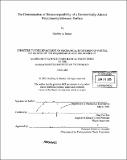The determination of hemocompatibility of a geometrically-altered poly(dimethylsiloxane) surface
Author(s)
Becker, Geoffrey A
DownloadFull printable version (2.692Mb)
Other Contributors
Massachusetts Institute of Technology. Dept. of Mechanical Engineering.
Advisor
Nam Pyo Suh.
Terms of use
Metadata
Show full item recordAbstract
Bio- and hemocompatibility are some of the driving forces behind medical device creation and materials science in this day and age. An experimental study was performed to test whether a geometrically altered surface of Poly(dimethylsiloxane), or PDMS, was found to be more or less hemocompatible than a flat, unaltered film of PDMS. In this case, the alteration was the addition of micron-scale posts sticking perpendicular to the surface, creating a superhydrophobic "bed of nails" effect. Once the specific altered surfaces were chosen, designed using Photolithography, and manufactured via a polymer casting process, a platelet adhesion assay was developed to assess the relative hemocompatibility of the surface via number of platelets counted on the surface of the altered vs. unaltered PDMS. Apparent contact angles of blood and Platelet-Rich Plasma (PRP) on the surface were also measured. The final instance of this experiment yielded positive results: The geometrically altered surface yielded less debris and platelet adhesion than did the flat PDMS surface, indicating an improvement in the hemocompatibility of PDMS via this process.
Description
Thesis (S.B.)--Massachusetts Institute of Technology, Dept. of Mechanical Engineering, 2005. Includes bibliographical references (leaves 38-40).
Date issued
2005Department
Massachusetts Institute of Technology. Department of Mechanical EngineeringPublisher
Massachusetts Institute of Technology
Keywords
Mechanical Engineering.